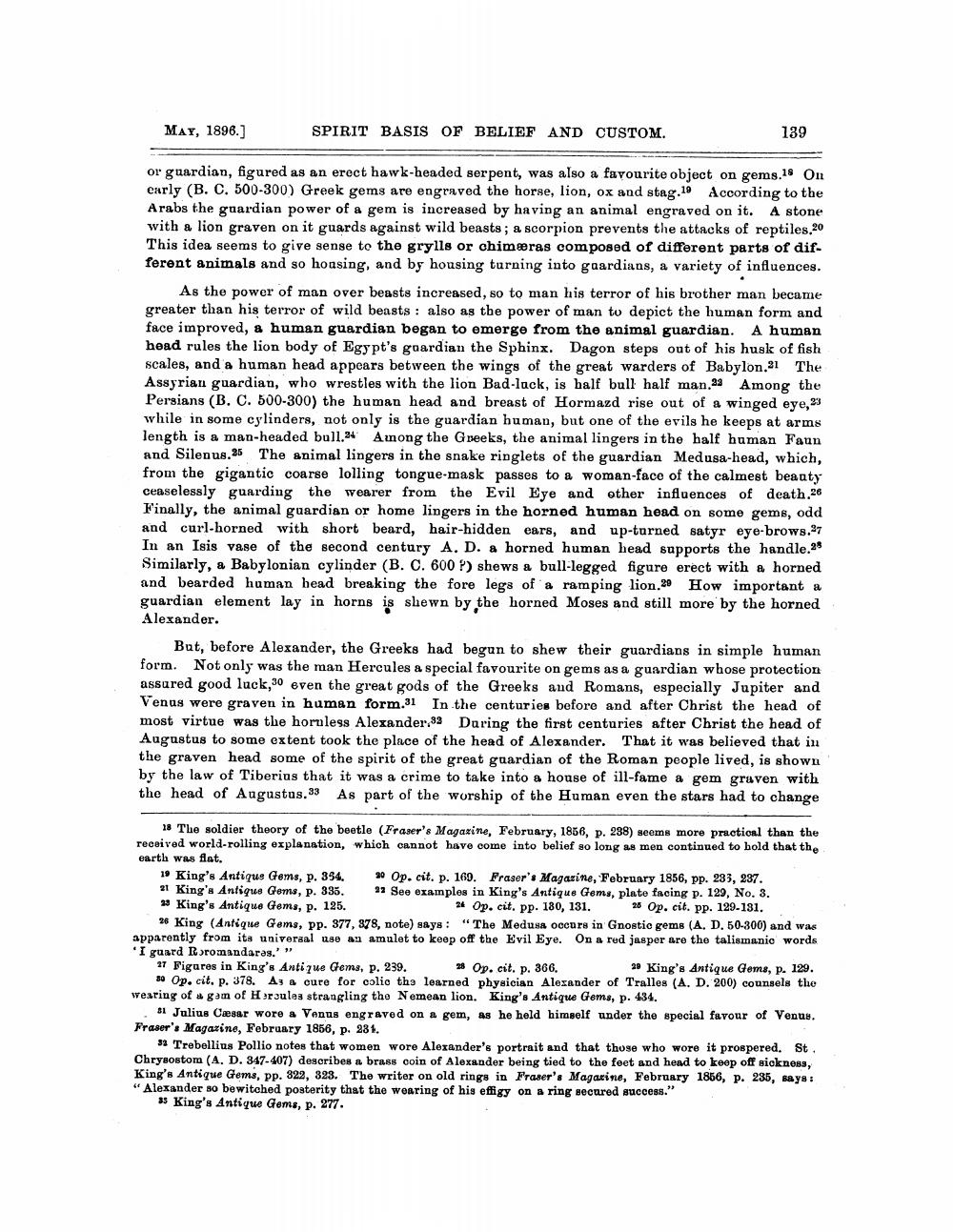________________
MAY, 1896.]
SPIRIT BASIS OF BELIEF AND CUSTOM.
139
or guardian, figured as an erect hawk-headed serpent, was also a favourite object on gems.18 On early (B. C. 500-300) Greek gems are engraved the horse, lion, ox and stag.19 According to the Arabs the guardian power of a gem is increased by having an animal engraved on it. A stone with a lion graven on it guards against wild beasts; a scorpion prevents the attacks of reptiles.20 This idea seems to give sense to the grylls or chimeras composed of different parts of different animals and so housing, and by housing turning into guardians, a variety of influences.
As the power of man over beasts increased, so to man his terror of his brother man became greater than his terror of wild beasts : also as the power of man to depict the human form and face improved, a human guardian began to emerge from the animal guardian. A human head rules the lion body of Egypt's guardian the Sphinx. Dagon steps out of his husk of fish scales, and a human head appears between the wings of the great warders of Babylon.21 The Assyrian guardian, who wrestles with the lion Bad-luck, is half bull half man.22 Among the Persians (B. C. 500-300) the human head and breast of Hormazd rise out of a winged eye, 23 while in some cylinders, not only is the guardian human, but one of the evils he keeps at arms length is a man-headed bull.24 Among the Greeks, the animal lingers in the half human Faun and Silenus.25 The animal lingers in the snake ringlets of the guardian Medusa-head, which, from the gigantic coarse lolling tongue-mask passes to a woman-face of the calmest beauty ceaselessly guarding the wearer from the Evil Eye and other influences of death.26 Finally, the animal guardian or home lingers in the horned human head on some gems, odd and curl-horned with short beard, hair-hidden ears, and up-turned satyr eye-brows.27 In an Isis vase of the second century A. D. a horned human head supports the handle.28 Similarly, a Babylonian cylinder (B. C. 600 ?) shews a bull-legged figure erect with a horned and bearded human bead breaking the fore legs of a ramping lion.20 How important a guardian element lay in horns is shewn by the horned Moses and still more by the horned Alexander.
But, before Alexander, the Greeks had begun to shew their guardians in simple human form. Not only was the man Hercules a special favourite on gems as a guardian whose protection assured good luck,30 even the great gods of the Greeks and Romans, especially Jupiter and Venus were graven in human form.31 In the centuries before and after Christ the head of most virtue was the horuless Alexander 32 During the first centuries after Christ the head of Augustus to some extent took the place of the head of Alexander. That it was believed that in the graven head some of the spirit of the great guardian of the Roman people lived, is shown by the law of Tiberius that it was a crime to take into a house of ill-fame a gem graven with the head of Augustus.33 As part of the worship of the Human even the stars had to change
18 The soldier theory of the beetle (Fraser's Magazine, February, 1856, p. 238) seems more practical than the received world-rolling explanation, which cannot have come into belief so long as men continued to bold that the earth was flat.
19 King's Antique Goms, p. 354. 99 Op. cit. p. 169. Fraser's Magazine, February 1856, pp. 233, 237. 21 King's Antique Goms, p. 335. 91 See examples in King's Antique Gems, plato facing p. 129, No. 3. » King's Antique Gems, p. 125.
24 Op. cit. pp. 180, 131. 25 Op. cit. pp. 129-131. * King (Antique Gems, pp. 377,878, note) says: "The Medusa occurs in Gnostio gems (A, D, 50-300) and was apparently from its universal use an amulet to keep off the Evil Eye. On a red jasper are the talismanie words "I guard Roromandaras.'" 11 Figures in King's Antique Gems, p. 239.
Op. cit. p. 366.
29 King's Antique Gems, p. 129. 50 Op. cit. p. 378. A3 & cure for colic the learned physician Alexander of Tralles (A. D. 200) counsels the wearing of gam of Horsules strangling the Nemean lion. King's Antique Gems, p. 434.
01 Julius Caesar wore a Venus engraved on a gem, as he held himself under the special favour of Venus. Fraser'. Magazine, February 1856, p. 281.
» Trebellius Pollio notes that women wore Alexander's portrait and that those who wore it prospered. St. Chrysostom (A, D. 347-407) describes a brass coin of Alexander being tied to the feet and head to keep off sickness, King's Antique Gems, pp. 822, 323. The writer on old rings in Fraser's Magazine, February 1866, p. 235, says: " Alexander so bewitched posterity that the wearing of his effigy on a ring secured success."
» King's Antique Goms, p. 277.




